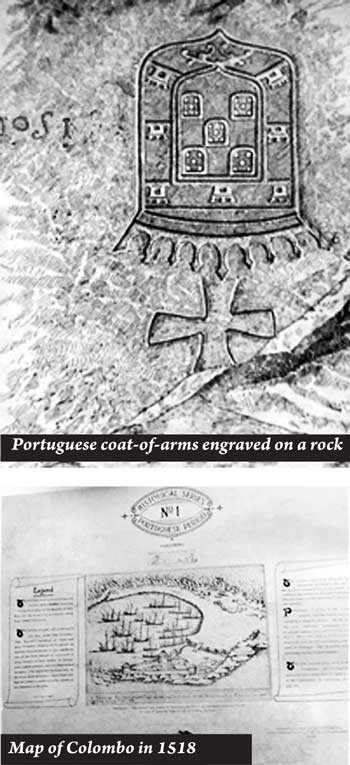Friday Mar 21, 2025
Friday Mar 21, 2025
Saturday, 23 June 2018 00:00 - - {{hitsCtrl.values.hits}}
 It was exactly 500 years ago, in 1518, that the Portuguese built a fort after arriving in Ceylon (as Sri Lanka was then known) in 1505, which the Portuguese historian Joao Ribeiro described as “the loveliest parcel of land the Creator had placed in this earth”.
It was exactly 500 years ago, in 1518, that the Portuguese built a fort after arriving in Ceylon (as Sri Lanka was then known) in 1505, which the Portuguese historian Joao Ribeiro described as “the loveliest parcel of land the Creator had placed in this earth”.
Although the Moors had been maintaining trade relations with Ceylon, this was the first time that a foreign power obtained land to erect a fort.
The Portuguese are said to have discovered Ceylon by accident when a fleet of nine ships led by Dom Lourenco de Almeyda bound for the Maldive Islands were caught in a storm and driven to Galle. Their mission was to intercept Muslim ships bound for Mecca.
From Galle the ships followed the coast line to the port of Colombo. On their arrival in Colombo, the Portuguese arms had been engraved on a rock in the harbour. It was not until 1898 that the coat-of-arms had been discovered and moved to Gordon gardens behind the present President’s House.
According to records, Captain Lopo Soares de Albegaria, Governor of Portuguese India, asked the King of Kotte for a plot of land “no more in extent than could be measured by stretching the dried hide from the carcass of a cow or bullock” to erect a trading station. They then used the site to build the fort. Cabook stones and mud were used to construct it. A garrison under the command of Captain Joao Silveyra was kept there.
Captain de Albegaria had set out for Ceylon in 1518 with a fleet to establish a fortress. Like the earlier fleet he too had been driven to Galle due to rough winds. He had spent several weeks in Galle and in fact, had toyed with the idea of building a fort in Galle. It is stated that he gave up the idea thinking that the Moors in Colombo would have said that they had frightened him off Colombo.
After coming to Colombo, de Albegaria met King Vijayabahu VI (1513-21) and persuaded him to allow him to erect a small fort in Colombo, indicating the need for a fort because of the Moors who were hostile to them. The Moors at the time were doing trading activities with Ceylon.
The busy nature of trade can be judged by Ribeiro’s reference: “Many ships from Bengalla, Persia, the South and the Red Seas used to assemble to take on board cinnamon and elephants, and here was carried on the trade of the island in other commodities which they brought.”
The Moors would have had friendly relations with the king and when they heard about the Portuguese wanting to build a fort they got alarmed and told the king not to trust the Portuguese. Although they told the king that they had never interfered with the internal affairs of the country, they could not convince him. Once the fort was built, the Moors with the help of the people began attacking the fort with no success.
 The Portuguese soon got involved with internal struggles between local princes who claimed the maritime provinces in the west coast. The fighting for power started between three brothers – Mayadunne, Rayigam Bandara and Bhuvaneka Bahu VII – when the latter succeeded Vijayabahu VI as king of Kotte in 1521. Mayadunne started ruling from Sitawaka and Rayigam Bandara from Rayigama. The Portuguese backed Bhuvaneka Bahu and the Moors supported one of the other brothers.
The Portuguese soon got involved with internal struggles between local princes who claimed the maritime provinces in the west coast. The fighting for power started between three brothers – Mayadunne, Rayigam Bandara and Bhuvaneka Bahu VII – when the latter succeeded Vijayabahu VI as king of Kotte in 1521. Mayadunne started ruling from Sitawaka and Rayigam Bandara from Rayigama. The Portuguese backed Bhuvaneka Bahu and the Moors supported one of the other brothers.
When Mayadunne attacked Colombo with the support of the Samorin of Calicut (Hindu monarch of the kingdom of Calicut in Kerala), he was routed by Bhuvaneka Bahu with the help of the Portuguese. In 1524 the Portuguese converted the fortress to a trading station or factory to please the king.
Discover Kapruka, the leading online shopping platform in Sri Lanka, where you can conveniently send Gifts and Flowers to your loved ones for any event including Valentine ’s Day. Explore a wide range of popular Shopping Categories on Kapruka, including Toys, Groceries, Electronics, Birthday Cakes, Fruits, Chocolates, Flower Bouquets, Clothing, Watches, Lingerie, Gift Sets and Jewellery. Also if you’re interested in selling with Kapruka, Partner Central by Kapruka is the best solution to start with. Moreover, through Kapruka Global Shop, you can also enjoy the convenience of purchasing products from renowned platforms like Amazon and eBay and have them delivered to Sri Lanka.
Discover Kapruka, the leading online shopping platform in Sri Lanka, where you can conveniently send Gifts and Flowers to your loved ones for any event including Valentine ’s Day. Explore a wide range of popular Shopping Categories on Kapruka, including Toys, Groceries, Electronics, Birthday Cakes, Fruits, Chocolates, Flower Bouquets, Clothing, Watches, Lingerie, Gift Sets and Jewellery. Also if you’re interested in selling with Kapruka, Partner Central by Kapruka is the best solution to start with. Moreover, through Kapruka Global Shop, you can also enjoy the convenience of purchasing products from renowned platforms like Amazon and eBay and have them delivered to Sri Lanka.